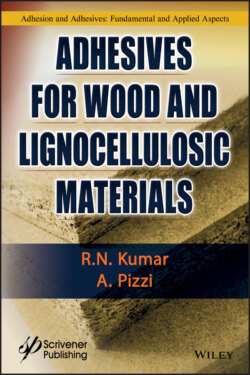Читать книгу Adhesives for Wood and Lignocellulosic Materials - R. N. Kumar - Страница 69
2.16.1 Some Results on Surface Energy of Wood
ОглавлениеAs discussed in Chapter 1, wood is a hierarchical cellular material and is therefore anisotropic in nature. Further wood surfaces are topographically different in radial, tangential, and transverse sections [31]. The wood surface consists of earlywood and latewood. The water contact angle of earlywood is often different from that of latewood. At the microscale, the wood surface consists primarily of lumen surfaces and cross-sectional walls. Thus, wetting of wood by the adhesives is therefore complex. Freeman was the first to report on the wettability of wood [39].
Gray carried out an extensive investigation on the wettability of 20 species of wood [7]. Gray was first to determine the surface free energy of wood. Sessile drop method was used to determine the contact angle, and the critical surface tension (γc) was obtained by the Zisman method. Species used by Gray were Western Hemlock (Tsuga heterophylla), Douglas-fir (Pseudotsuga taxifolia), Afrormosia (Afrormosia elata), Parana pine (Araucaria angustifolia), European redwood (Pinus sylvestris), English oak (Quercus robur), and Beech (Fagus sylvatica). The values of critical surface tensions ranged from 34.5 to 81.0 mJ/m2. One of the important findings was that freshly sanded surfaces were approximately 20 mJ/m2 higher in surface energy than un-sanded, aged surfaces. It was also shown that surface contamination occurs rapidly on freshly cleaned surfaces.
Herczeg reported on the wettability of Douglas-fir wood [40]. The critical surface tensions, γc, were found to be between 44 and 50 dynes/cm for summerwood and springwood, respectively. The surface-free energy and the maximum work of adhesion were also reported. It was also reported that aging increased contact angle, showing that wood wettability was reduced. Chen reported that removal of extractives from some tropical woods improved wettability [41]. Hse measured the wettability of southern pine veneers by measuring the contact angles formed with 36 phenol-formaldehyde resins [42]. The contact angle of resins on earlywood was less than that on latewood, apparently because earlywood surfaces were rougher. Also, the contact angle was positively correlated with the glue bond quality as tested by wet shear strength, percent of wood failure, and percent of delamination. Nguyen and Johns found that the surface free energy of Douglas-fir and redwood decreased with aging time [43]. Extractives and aging had significant influence on the surface energy. The surface free energy of Douglas-fir was 48.0 mJ/m2, and after extraction, it increased to 58.9 mJ/m2. These results emphasize the influence of extractives on the wood surface energy.
Kalnins et al. [44] employed a video-type technique to measure the dynamic contact angle of distilled water as test liquid on wood with measurements conducted at the elapsed time of 3 to 5 s.
Gardner et al. found dynamic contact angle measurements to be useful for determining the effect of wood processing and environmental conditioning on surface energetic [45].
Kajita and Skaar evaluated the wettabilities of the surfaces of some American softwoods species (using cosine 0 as the index of wettability) [46]. Also, the earlywood wet more easily than did the latewood (earlywood has a greater roughness factor and a greater porosity). The wetting angles varied from 68° (eastern red cedar) to 14° (Alaska cedar). The greater wettability of sapwood compared with heartwood was attributed to the extractive content of the heartwood.
Cosine of the advancing contact angle was employed as the measure of wettability. The wettability, pH, and specific gravity were closely related to glue-bond quality of resorcinol-phenolic and urea formaldehyde-bonded adhesive joints [47].
Shi and Gardner developed a wetting model to describe to quantify the adhesive penetration and spreading during the adhesive wetting process [8]. Sapwood and heartwood of southern pine and Douglas-fir were studied. Two resin systems, polymeric diphenylmethane diisocyanate (PMDI) and phenol formaldehyde (PF), were evaluated. It was learned from this study that the wetting model could accurately describe the dynamic adhesive wetting process on wood surfaces. Shen et al. presented a systematic study of surface free energy and acid–base properties of pine (P. sylvestris L.); for evaluation of the data, the Lifshitz–van der Waals/acid–base (LW–AB) approach was applied [48].
Nussbaum observed a decrease of wettability as a function of time on wood surface after sawing due to the migration of wood extractives to the surface [49]. Gindl et al. compared the applicability of different approaches to determine the surface free energy of wood and found the LW–AB approach to be the most effective among the generally accepted models [50].
de Meijer et al. [51] employed contact angle measurements to calculate the Lifshitz–van der Waals, acid–base, and total surface free energies of wood species spruce (Picea abies) and meranti (Shorea spp.). These species were characterized by low surface energy with a dominant Lifshitz–van der Waals component. The authors report that thermodynamic equilibrium conditions as assumed by Young’s equation are generally not fulfilled with wood surfaces because of chemical heterogeneity, surface roughness, and the adsorption of the test solvent.
An exhaustive review of wettability of wood has been published by Piao et al. [31]. The review also includes calculation of surface tension of wood, Zisman’s critical surface tension, Owens–Wendt’s geometric mean, and Wu’s harmonic mean; Young–Fowkes–van Oss–Good acid–base approaches and the inverse gas chromatography method have been discussed in detail. The review also deals with variables that affect the wettability and surface energy of wood. Detailed overview of literature data obtained on wood surfaces was presented by de Meijer et al. [51].
